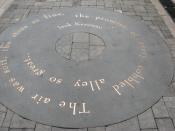Kerouac and Bukowski- Two Sides of the Beat Coin
The Beat generation of the 1950's and 1960's was just that- beat. Exhausted and disillusioned by two World Wars and the Korean War, the beatniks were tired of society, disgusted by violence, and eager to dismiss the so-called American dream. In many ways, Jack Kerouac was the first of the bookends for this generation; Charles Bukowski was the last. Women : A Novel by Charles Bukowski and On the Road by Jack Kerouac carry many stylistic similarities due to the influence of the Beat generation; however, the differences in character development in the two novels exhibits the contrast between the personalities and beliefs of the two writers.
Sal Paradise in On the Road and Henry Chinaski in Women : A Novel have remarkably similar character structure. Both are semi-autobiographical anti-heroes, writers with a difficulty grasping how the rest of the world functions.
They resist any constancy in their lives. Sal travels across America and to Mexico, unable to keep hold of endless transient and poisonous friendships. Chinaski travels around North America, chasing after the stream of younger women that throw themselves at him. They have issues with alcoholism and drug use, a common theme in Beat literature (The Literature Network). Both Kerouac and Bukowski wrote their novels to describe and seek truths about themselves- in many ways, it is difficult to separate the fiction from the authors' reality. While the similarities between the protagonists is telling of the common threads between the two authors- especially the influence of the Beat movement. However, the differences between the two characters are far more descriptive into the true purposes of both novels, and the true natures of the the authors themselves.
The most massive difference between Kerouac and Bukowski is their individual belief in...


